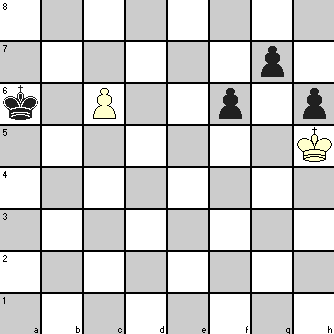In the view of experts, it is in the endgame that an amateur is most likely to falter and the difference between an expert and an amateur becomes apparent during this phase. That is why we have dedicated quite a good number of articles on endgame tactics.
Knowing appropriate techniques is important no doubt, but because of the limited number of pieces on board, a player often needs to show qualities of a higher order like imagination, vision, invention, subtlety, perception of unusual possibilities etc. to come out a winner consistently. We have stressed the need to study endgames from master play in the article on chess tactics in endgames but did not discount the usefulness of studying endgame compositions by experts that brings out specific ideas you can put to use.
To see if you have learned your lesson from the article referred above, we give below another composition by the same Grandmaster, where White has to move and draw following similar principles. See if you can find the solution (given at the end of this article)!

In the following composition, White is required to play and win. If White tries d8=Q immediately, Black will play Rb8 forcing White to capture the Rook by Qxb8 and Black gets a draw due to stalemate!

| 1. | Nb2 | Rf1+ | The Knight blocked the Rook’s check on rank 8 and if 1. … Rxb2, White pawn queens. The Knight also guards d1 square against Rd1+ by Black at move 3. | |
| 2. | Ke7 | Re1+ | ||
| 3. | Kd6 | Re2 | If White tries 4. d8=Q, Black is ready to play 4. … Rd2+ capturing the Queen | |
| 4. | Nc4 | Re1 | The Knight prevents 4. … Rd2+, so Black gets ready for 5. … Rd1+ | |
| 5. | Nb6 | This wins for White. If 5. … Kxb6 6. d8=Q+ . If 5. … Rd1+ 6. Nd5 and Black cannot prevent the pawn promotion |
The following position, though a composition by English chess Master Joseph Blake, can possibly occur in real games. This shows some very inventive ideas on the part of both players though White is required to play and win.

The points to note for White’s move is that a check on rank 8 will mate the Black K once White K unblocks by moving to rank 7. RP of both players are ready to Queen, but White Q cannot capture Black Q on a-file as it will result in stalemate and draw.
Black on the other hand will try to force capture of his Q on a-file for reason explained above. As White tries to avoid it, Black will try to place his Q on rank 7 preventing White King’s move to that rank to unblock rank 8.
Let us see what tactics by White will overcome Black’s resistance and deliver checkmate.
| 1. | h8=Q | a1=Q | ||
| 2. | Qg8 | Qa2 | To avoid capturing Black Q on a-file and being captured itself, White Q shifts along rank 8 and Black Q shifts along a-file to be in opposition to White Q | |
| 3. | Qe8 | Qa4 | Why the White Q couldn’t go to e8 in move 2? If 2. Qe8, then Black plays 2. … Qg7 and White K cannot move to rank 7. If White tried 2. Qf8, Black would play 2. … Qa3 followed by 3. … Qd6+ | |
| 4. | Qd5+ | Ka8 | ||
| 5. | Qh8 | This wins. Black cannot bring his Q to a1 in opposition to White Q which can now capture Black Q with a check. If Black Q tries to give a check, White K will move to rank 7 with discovered check and mate by his Q |
A lot of inventive ideas have been packed in apparently simple situation. You now understand how to consider different possibilities and to plan for taking care of those to achieve your target.
***********************
Solution to the problem:
| 1. | Kg6 | f5 | ||
| 2. | Kxg7 | f4 | ||
| 3. | Kf6 | f3 | 3. … Kb6 4. Ke5 f3 5. Kd6 ends in a draw | |
| 4. | Ke6 | f2 | ||
| 5. | c7 | drawn |
Other Interesting Related Posts you should read:



One Comment
[...] Chess tactics: managing endgames [...]